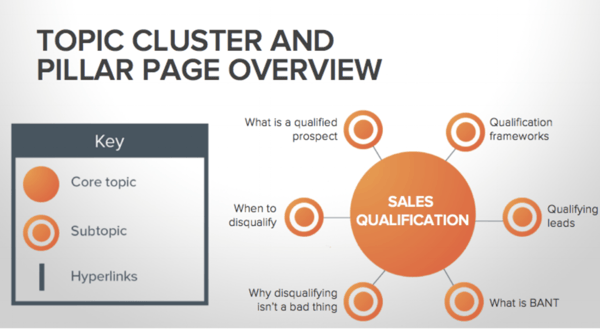In the last article I wrote, I talked about how HubSpot removed their keywords tool and asked the question: “Are Keywords Dead?” Today, I’d like to talk about the new systems that are poised to replace keywords as the central planning tool for your inbound marketing strategies: Pillar pages, topic clusters, and subtopics.
What’s a Pillar Page?
A pillar page is a comprehensive resource that covers a “core” topic that is central to your business in depth. An example of a core topic for Bluleadz would probably be “inbound marketing.” Such an inbound marketing pillar page would be a resource that covers as many things about inbound marketing as we could possibly put on a single page.
These pages are meant to provide a robust and useful resource for website visitors that they can use to answer the majority of the questions they may have about a particular topic related to your business.
What Are Topic Clusters?
Jessica Fender, a content officer from OnlineWritersRating.com, wrote a blog piece about topic clustering for the BZ blog not too long ago. To borrow her terminology a topic cluster “represents a group of very similar items that can easily be fitted into the same category, like with a common topic.” Topic clusters are a part of the pillar page, yes, but they also contain any other content that you might have which is related to that pillar page.
For example, say you have a topic cluster for “inbound marketing.” This topic cluster would involve the inbound marketing pillar page as well as any offers that you’ve written on the subject of inbound marketing.
Where Do Subtopics Fit in?
Subtopics are shorter pieces of content that address specific questions about a core topic from a pillar page.
Basically, the structure of pillar pages, topic clusters, and subtopics could be represented like this:

Now, the question is, how can you transition from keyword-based blogging to this new pillar page and topic-cluster based system?
The answer may be that it’s surprisingly simple—if you’re willing to change the way you think about keywords.
Making the Jump from Keywords to Pillar Pages and Topic Clusters
HubSpot has a convenient knowledgebase article that answers the question of what pillar pages, topic clusters, and subtopics are, and even goes so far as to highlight some best practices for validating a core topic—such as checking domain authority and monthly search volume for that topic.
This might sound familiar to you if you’ve read some of our previous blogs about using keywords. When choosing keywords, it was almost always a good idea to check for the amount of monthly searches there was for a given term, as well as the level of competition for the term and whether or not you currently rank for them.
If you have a high domain authority, you’re more likely to rank high for a specific topic when you write about it. As such, building your domain authority is a key part of making the jump to using pillar pages and topic clusters. The question is: how can you improve your domain authority so you rank high for topics with a high search volume?
Thankfully, there’s another Bluleadz post with some useful advice in this area, which I will summarize here:
- Check Your Current Page Rankings. Delve into your data to see how you’re currently ranking—Moz’s Domain Authority tool is super useful for this.
- Focus On Link Building. Getting other sites to cite your content and link back to your site is an excellent way to build domain authority. Additionally, try to get high-quality, authoritative backlinks from reputable organizations and use Google’s disavow tool to do away with low-quality, questionable links.
- Research Your Competitors. You should take a look at what your biggest, most successful competitors are doing and see if there aren’t any lessons you can take from them.
- Optimize Your Site’s User Experience (UX). A clunky, hard-to-navigate site can put off potential website visitors. This, in turn, can keep others from wanting to link to your site’s content. So, be sure to do what you can to improve your site’s UX so people can find your top-quality content with as little frustration as possible.
- Use Internal Links. Have another great piece of content that’s on a related topic? Link to it! Internal links help you build your domain authority a bit while pointing readers to relevant resources which they might enjoy or could help explain a concept in more detail.
- Make Good Content! Part of getting those high-quality backlinks from reputable organizations and websites is making sure you have content worth sharing. Don’t just write any old thing and throw it up on your site—pun intended. Take the time to do your research, edit what you write, have others review it, and put some thought into the visual design. You’ll have a better piece of content you can take pride in, and one that others will want to share.
The other major step in switching to pillar pages and topic clusters is to actually build a pillar page. This can be a daunting proposition, since the whole point of a pillar page is to take a topic and really drill down into to answer all of the big questions about that topic in detail.
It can help to think of writing a pillar page as kind of like writing an eBook—albeit one that you’re going to publish on your website without the usual gates (i.e. forms) that you would normally put between readers and the resource.
In fact, if you have an old eBook that gets some good results for your company, it might help to start by converting that eBook into a pillar page, and use the old offer as the downloadable version for your website’s visitors. This can help you jump-start your pillar page creation.
Additionally, don’t be afraid to add onto the pillar page at a later date if you think of something that’s missing from it which might help to improve it or make it more thorough. However, when you do add to the page, be sure to consider how this will affect navigation on the page—making people scroll way down the page to get to the bit of info they want is not an optimal user experience.
Consider adding <a href> tags to your pillar page’s content so users can quickly jump to specific sections of the page.
Finally, create a bunch of other content (especially blogs) related to your pillar page’s topic, and be sure to link back to the pillar page so people can find it! This helps with your internal link strategy while making your pillar page easy to discover for recurring visitors who are subscribed to your other content. Consider making a promo email to help promote the new pillar page as well.


Douglas Phillips
Former military brat, graduated from Leilehua High School in Wahiawa, Hawaii in 2001. After earning my Bachelor's in English/Professional Writing, took on a job as a writer here at Bluleadz.